A World Away, So Near
On May 19th 1924, the BBC made history with its first live broadcast of a wild animal, setting its microphones and sound equipment in the leafy Surrey garden of cellist Beatrice Harrison as she performed a duet with a nightingale. Against all of the expectations of BBC founder Lord Reith at the time, who reluctantly agreed to the idea despite believing the nightingale would be an uncooperative prima donna in its role, the broadcast proved profoundly entrancing, commanding an estimated audience of a million listeners and making Harrison internationally renowned. She was the recipient of 50,000 pieces of fan mail in response to the serenades, some of them addressed simply to The Nightingale Lady. Staying faithful to the precise date and place —even after Harrison eventually moved houses and the nightingales became the sole performers— that day marked the beginning of a yearly broadcast tradition that lasted until 1942 when the Second World War abruptly intervened. On May 19th of that year, as BBC sound engineers were about to go live to an expectant audience with nightingales on the airwaves again, a squadron of RAF planes loomed into the Surrey sky. Comprising 197 Wellington and Lancaster bombers, the squadron was flying east towards Mannheim in Germany on a bombing raid at the height of the war. Realising that a live broadcast of the aircraft could easily compromise the mission if being listened to in Germany, the sound engineers swiftly cut the feed.
Although that temporary confluence of bombers and nightingales was never aired, an archive recording of the day still exists. On one side of the disc can be heard the drone of the departing aircraft as they pass over the garden, while the other has them returning in the aftermath of the raid, minus the eleven planes that went missing on the mission. Both are woven with singular and soaring song. I know of few more poignant and haunting sounds than those brief minutes when nightingales, singing in search of a mate after their long and arduous journey from Africa, share the spring air with a dense flock of bombers. There is a compressed fragility to it all — a tense, suspended beauty, as if that particular point in time was held momentarily in balance, tilted so easily into oblivion. Above the ecstatic, pulsing songs gathers the murmur of distant aircraft on the horizon. Merely a purr at first, something at the very edge of hearing, the sound rises to an ominous drone until it’s nearly equal to the nightingales in volume, underpinning their songs with a deep and continuous thrum before fading like smoke into the distance. Theirs is a brief and unusual unison, the strange, hypnotic braiding of sentience and machine, a moving threnody to life, struggle and death.
That recording, now 74 years old, resonated greatly with me this June when I joined a group of artists, ecologists, writers, historians and photographers in Kent for a project entitled Reimagining Lost Landscapes. Brought together by a charity called People Need Nature, we’d been asked to explore and reflect upon the former military base of Lodge Hill on the Hoo Peninsula, recording and documenting its cultural and natural aspects while considering its various values, whether historic, environmental or spiritual.
Alongside eleven other military bases, Lodge Hill is mothballed and being disposed of by the Ministry of Defence as it aligns itself with new strategic realities and financial concerns, shedding some of its extensive portfolio in the process. Currently in the hands of the government’s Homes and Communities Agency and, depending on the outcome of a public inquiry in 2018, potentially slated to be the site of a new town consisting of 5,000 houses, it’s a large and extraordinary place spread along the ridge of the peninsula and partially nested within a wooded vale. Utilised by the military for a variety of purposes over the decades, Lodge Hill also teems with impressive natural habitats that are inextricably bound up with spaces of human use. So interwoven are they that it’s impossible to untangle them, much like those two strands of sound that coalesce on the recording, a recording that never seemed far away as we explored the base in sharp sunlight and drenching summer rains. As the stronghold of Britain’s dwindling nightingales, Lodge Hill is listed as a protected Site of Special Scientific Interest on their behalf, supporting 1% of the nation’s entire population. And so those few, unrepeatable minutes in a Surrey garden, magnified by time and lent depth by distance, came to embody the place for me, the long-twined histories of nature and war.
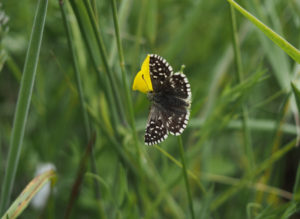
Grizzled Skipper © Julian Hoffman
From the moment we began our obligatory safety induction at the gatehouse, the worlds of natural and military history appeared to coincide, like parallel lines running together in the distance. As though a field guide to an unfamiliar country, we were shown through a ring binder of explosive ordnance that could still be potentially encountered on site. We might have been leafing through a book of orchids, waders or wildflowers the way each of the images entranced —the subjects of the photographs as startlingly vivid in their forms and features as their natural history equivalents— but the security guard named a checklist of species that had none of their sensuous appeal: artillery projectile, anti-personnel landmine, area denial sub-munition, air-dropped high explosive. It was a field guide that focussed awareness more than most, revealing the essence of the site’s history right back to its beginning.
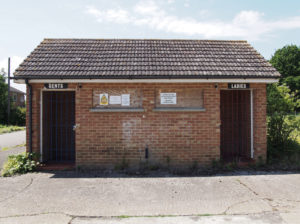
Public Loos on “Newry Road”. Used to train the Bomb Squad. © Julian Hoffman
Designed as a naval magazine for the storage of munitions in 1870, Lodge Hill brims with the historical signifiers of its times. As an active base for over 130 years, being there is like watching archive film projected onto the landscape, gathered together and sequenced by era. From the grand Victorian vaults of elegant brickwork and arched windows to Britain’s first anti-aircraft battery, built to protect the munitions stores and still standing in ghostly ruins atop a ridge since 1913, the place takes you through successive ages within a matter of steps. There is no forewarning or sign as to what you might discover next. By the time you reach a replica street, screened by dense woodland and scattered with bee orchids and wild bee hives, you’ve arrived in Belfast during the Troubles. By then Lodge Hill had been transferred from the jurisdiction of the Navy to the Army, and this facsimile housing estate, as detailed and convincing as a Hollywood set, was raised to train soldiers in guerrilla tactics, urban warfare and bomb disposal techniques before being stationed in Northern Ireland. The scene is unnervingly authentic down to its smallest touches — the neighbourly back gardens where it’s easy to imagine people chatting across fences over morning tea, the block of public toilets graced with Ladies and Gents signs, and the startling IRA mural of a Republican fighter painted on a wall at one end of the terraced houses. Only a few hundred feet away, or one street over in the scheme of things, the base’s Newry Road, signposted in the same manner as the parallel world that exists outside the base, must have been recast in the 1990s in light of new military priorities and done up with corrugated metal siding and flypostered with fading images of Osama bin Laden and the Ayatollah Khomeini. Conjuring the mirage of a Middle Eastern city for Gulf War training purposes seemed futile amidst the sheeting English rain, the inescapable absurdity of imitating a region of deserts amidst the lush tangle of brambles and wild roses, yet those posters of bin Laden and the Ayatollah, their eyes scrapped away to the silver metal beneath, chilled all the same. Wherever you go in Lodge Hill, you feel as though you’re somewhere else as well.
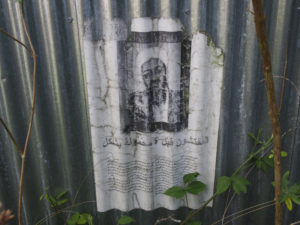
Osama Bin Laden Poster © Julian Hoffman
For obvious strategic reasons, military bases have an essential secretiveness about them, a discreetness that wraps them like bark. It’s what lends an element of the surreal to exploring one, where an ominous and unnerving street from conflict-scarred Belfast can sit alongside more commonplace sectors where wall-building and truck-loading are practiced, the utilitarian, but no less essential, aspects of warfare within a training regime. Though heavily invested in their operations as citizens of the nation they’re meant to protect, we know very little of the minutiae that compose a military site. They exist necessarily beyond the public gaze, publicity-shy places cordoned off behind high metal fences and barbed wire, and kept insulated from the larger tides of livelihood and land use that have swept across the countryside. They’re of our world, and yet different – managed in accordance with rules and requirements not reliant on the chemical needs of intensive agriculture or the economic pressures for growth and development. They’re maintained for combat and conflict in their many guises, and sometimes that essential difference in intent inadvertently produces habitats especially conducive to wildlife.
Soon after stepping into a sloping meadow beyond the gatehouse, species which are uncommon, or in serious decline, across Britain began appearing as we walked. In bursts of scattered June sunlight, dyer’s greenweed glowed yellow amidst the grasses, increasingly rare grizzled skipper butterflies skimmed the flowers of creeping buttercup and stitchwort, and a brown-banded carder bee was swept up in a net by entomologist Steven Falk, a species that has vanished from most counties and declined by as much as 70-80% since the 1950s. As well as being rich and important repositories of military history, sites with significant cultural value where important aspects of the nation’s military and political past, and in many cases its future, have been forged over a long period of time, active and former bases often exist as islands of diversity in a sea of increasing biological paucity. They’re places that, in more ways than one, remember the past, frequently acting as home to creatures that are being gradually cast out from the countryside. “Scarcer bumblebees speak a lot about landscape quality,” said Steven, holding the carder bee in a plastic tube for us all to see. “They need large amounts of the right flowers from spring until autumn across vast areas, so bumblebees effectively act as barometers of environmental quality.” Steven removed the lid from the tube. “This is as important as a nightingale,” he said, releasing the bee on the wind.
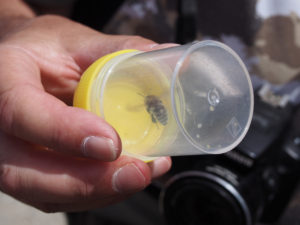
Brown-banded carder-bee © Julian Hoffman
From the flower-spun meadow I’d heard a few snatches of far nightingale song followed by silence, the kind of silence that H.E. Bates described in 1936 as the “breathless hushed interval,” but it wasn’t until we’d dropped down through the rippling grasses that we finally heard one up close. It’s a song that’s irrevocably slipping away, like sand in an hourglass. Having “lost 43% of its former range and declined over 90% since the 1960s,” the British Trust for Ornithology believes the nightingale could be extinct in the UK within the next two to three decades. But despite its staggering national decline, Lodge Hill remains home to a significant number of its kind, hosting around 80 pairs, the most to be found in any one place in Britain, partially as a result of the former military management of the land for bomb disposal training. Clear-cuts were mown in parallel lines through scrub where soldiers practiced the craft of defusing, leaving dense thickets to develop between them, unintentionally producing the ideal habitat for nightingales, a suite of dense scrub and clearings, a world of multiple edges where the bird can easily command territory, nest and feed in safety. While the base has emptied of soldiers, the nightingales, for now, remain.
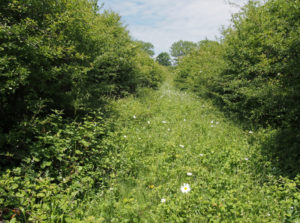
Scrub created for military training, provide homes for Nightingales. © Julian Hoffman
There is no wild song in Europe that’s been more revered down the centuries that the nightingale’s, honoured and praised by such poets and philosophers as Keats, Milton and Pliny, and tuned in to by a million people on their wireless sets in 1924 to hear a single bird duet with a cellist, or listened to down phone lines to the living rooms of relatives by those without radios that day. In his book The South Country, Edward Thomas encapsulates this veneration when he writes that nightingale song reminds us that “earth is something more than a human estate, that there are things not human yet of great honour and power in this world.” And yet while much of the country falls increasingly silent of their irrepressible and celebrated refrain, becoming reliant on poems, recordings and stories of the bird instead, as if solely a museum piece rather than a living, breathing creature, here was a place where it still rings as clear as water from the copses and scrub each spring, that spill of rolling, trance-like notes and staccato trills, the swelling and mesmeric spell cast by such a small and physically inconspicuous thing.
Though we were meant to be considering loss during our time on site, what might vanish if Lodge Hill is to be developed into a town of 5,000 homes, it was the currency of gain that seemed more appropriate to acknowledge. Behind those high fences and walls that have sealed Lodge Hill from public view for over 130 years is a place of singular and unexpected wealth, a mosaic of deserving historical value, natural profusion and remarkable military interest. It’s a reminder of times long gone, but also a place of refuge and resilience in a contemporary sense, harbouring a richness that has often gone missing from other landscapes as a result of agricultural practices and development. And in the case of a remarkable wild bird it’s a place of strange fortuity, where bombs and nightingales are once again entwined, enabling a species to locally thrive amidst its national diminishment. As we explored Lodge Hill I couldn’t help but think of that day in May of 1942, how together the bombers and birds evoke something other than their individual sounds customarily do, those things of “great honour and power in this world.” Instead it’s a hymn to fragility, to all that is insubstantial and unrecoverable about these lives and environments, reminding us of how tenuous everything is. But as those eleven aircraft fell flaming to earth, and explosions tore open the city of Mannheim from the sky, the nightingales continued to sing loyally into the Surrey air for a mate, a world away, yet unmistakeably belonging to it and necessary as well.
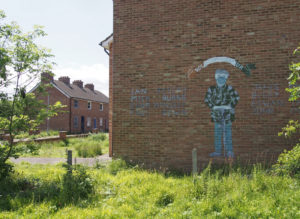
“IRA Street Mural”, Lodge Hill Kent. © Julian Hoffman
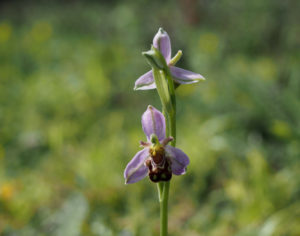
Bee Orchid by the IRA mural. © Julian Hoffman

[…] Hoffman reflects on ‘the long-twined histories of nature and war’ at Lodge Hill, a former military base on the Hoo Peninsula, as part of a project entitled […]